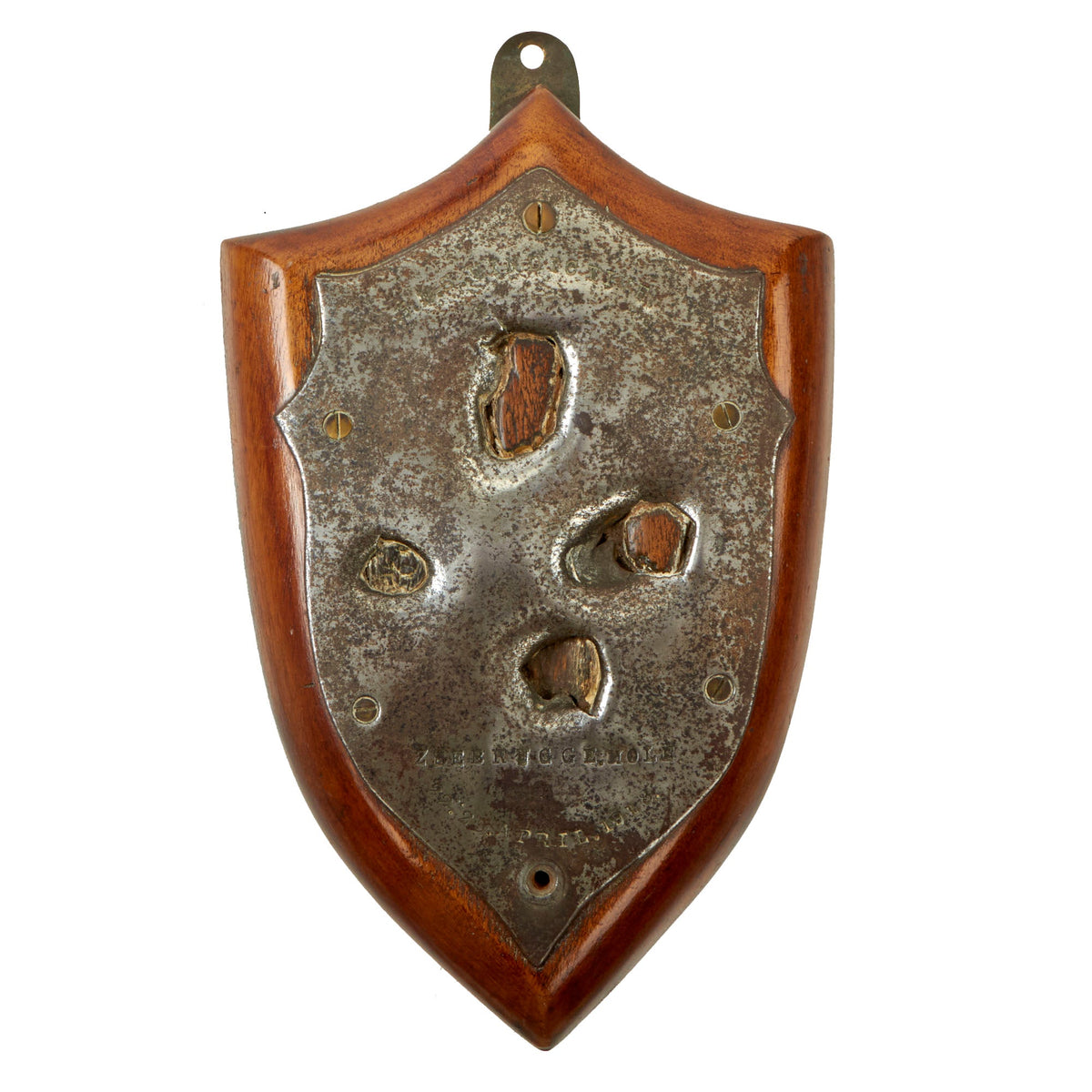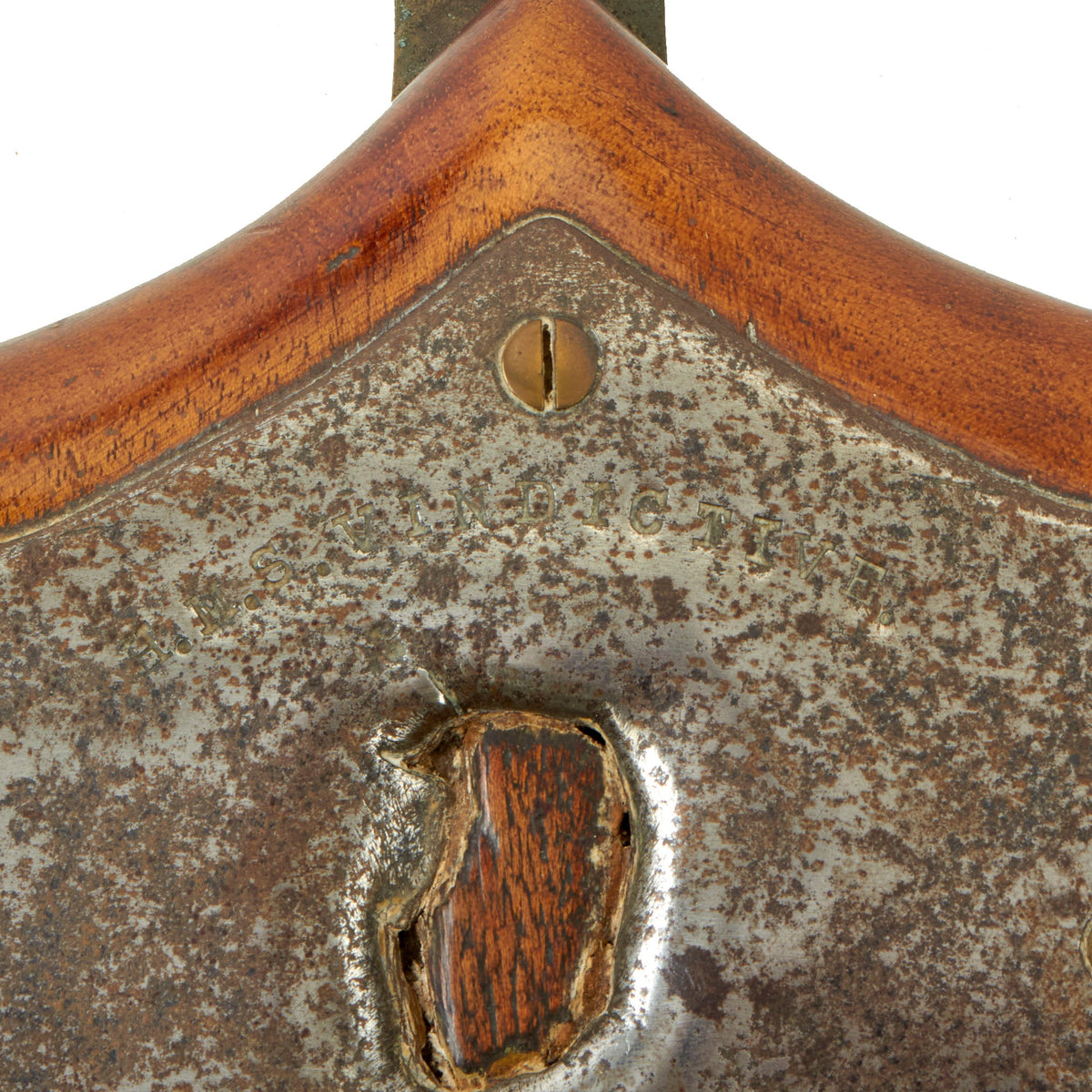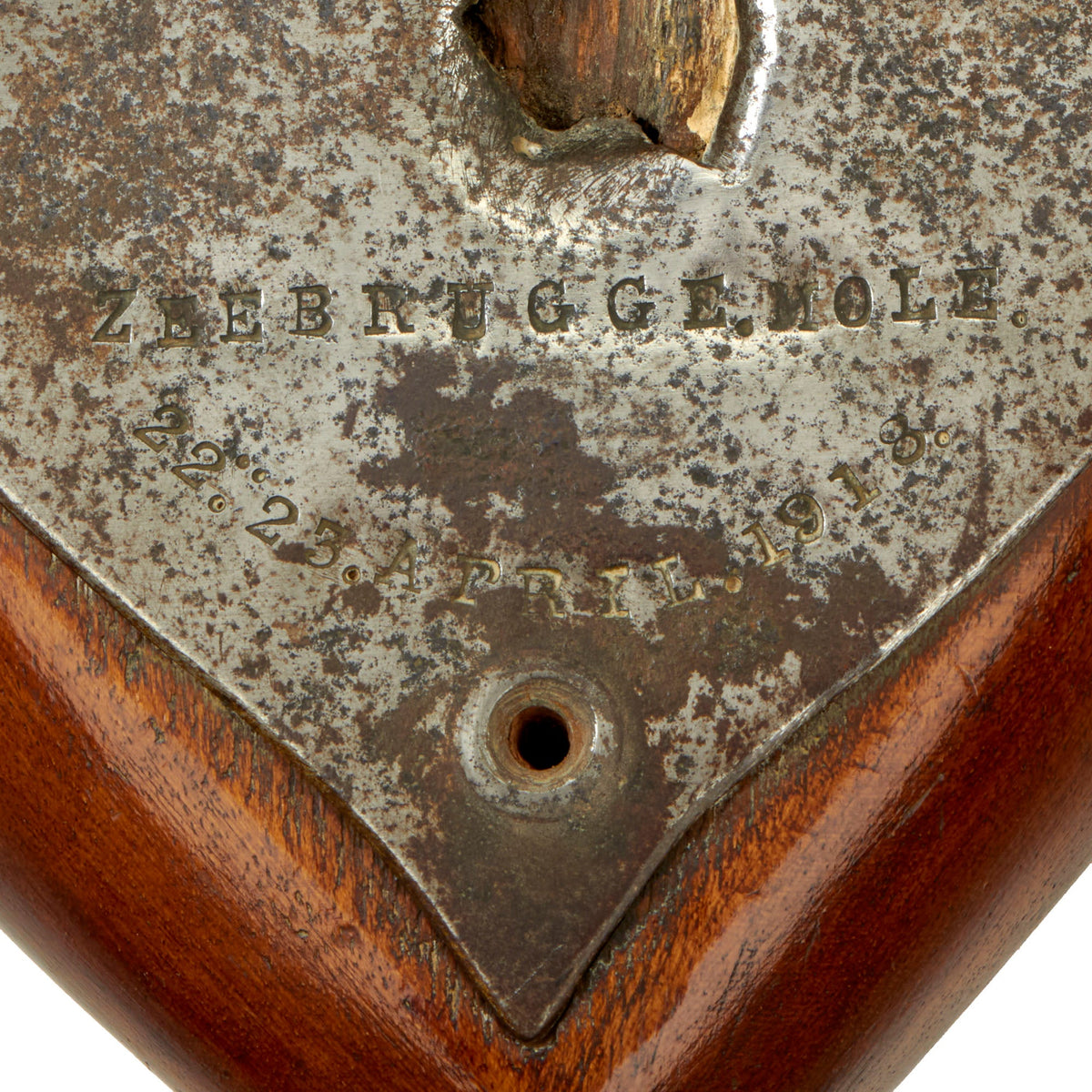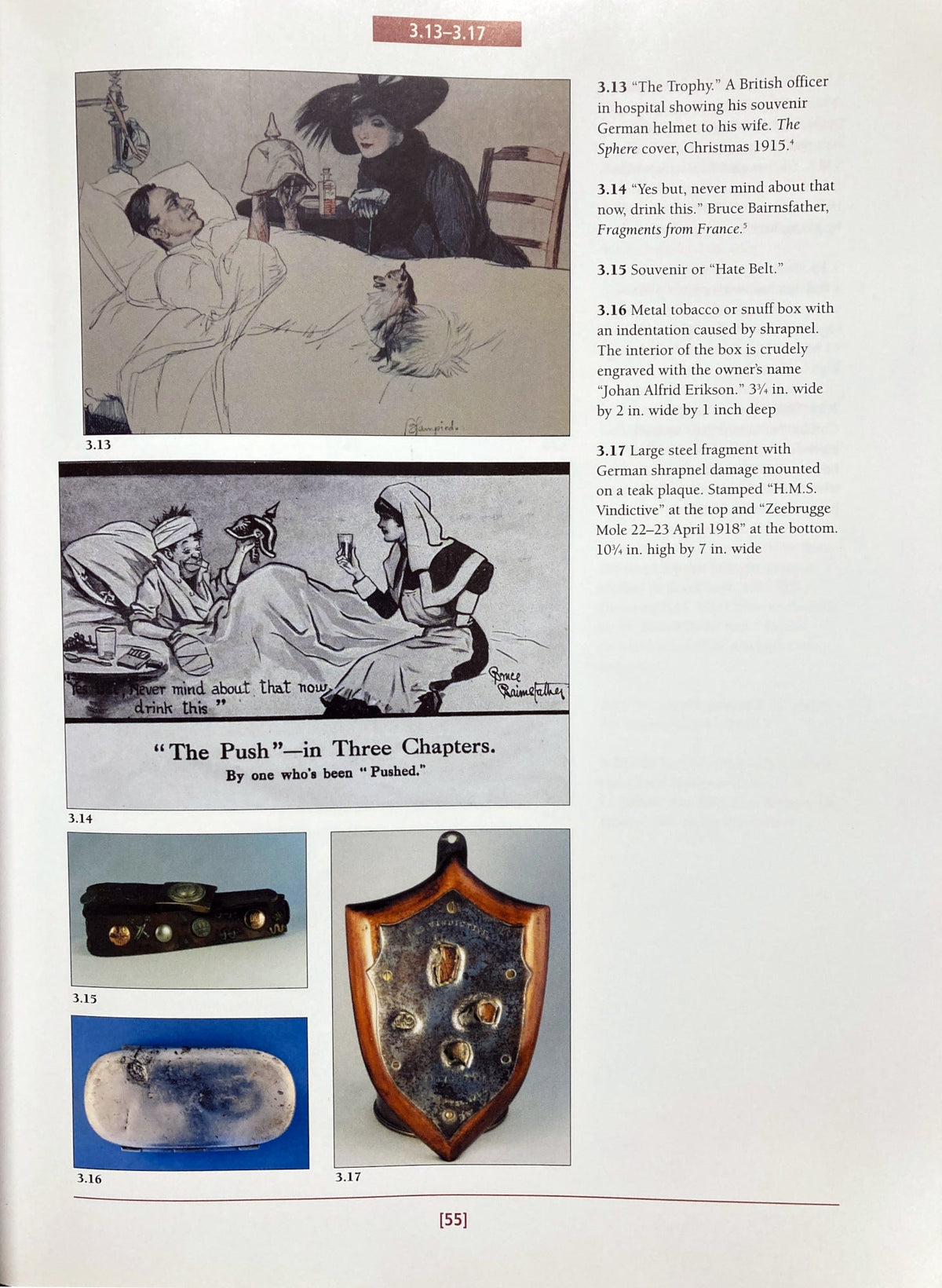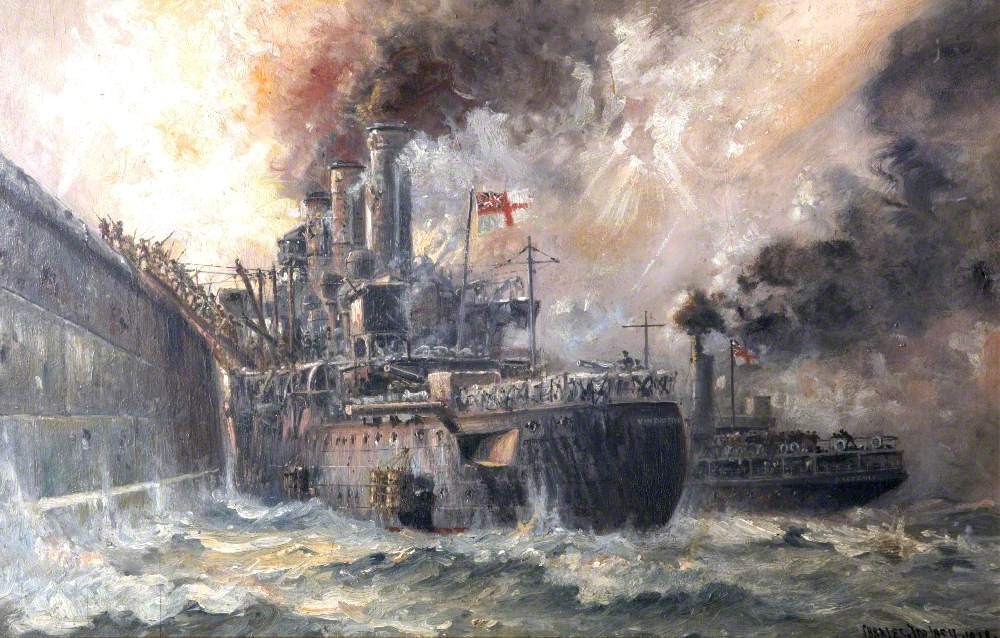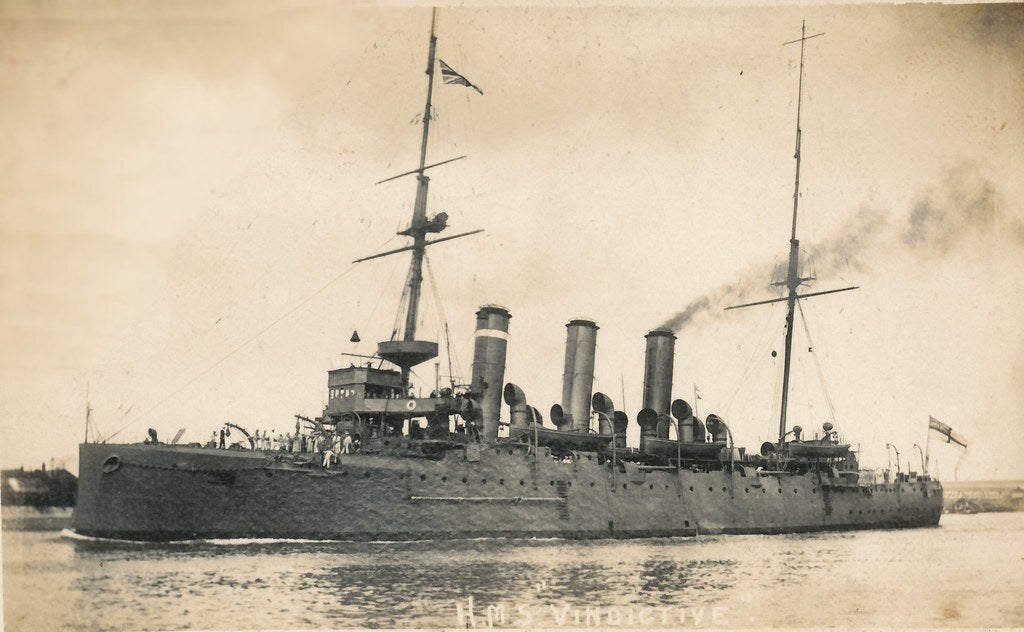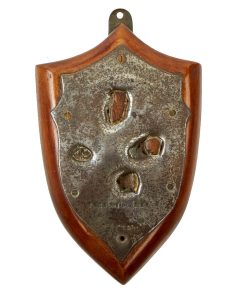Original British WWI Trench Art Wood Shield With Battle Damaged Steel Section From HMS Vindictive, Sunk During Zeebrugge Raid, As Featured In The Book “Trench Art, An Illustrated History” by Jane Kimball on Page 55 Original Items
$ 495,00 $ 148,50
Original Item: Only One Available. Trench art is any decorative item made by soldiers, prisoners of war, or civilians where the manufacture is directly linked to armed conflict or its consequences. It offers an insight not only to their feelings and emotions about the war, but also their surroundings and the materials they had available to them.
Not limited to the World Wars, the history of trench art spans conflicts from the Napoleonic Wars to the present day. Although the practice flourished during World War I, the term ‘trench art’ is also used to describe souvenirs manufactured by service personnel during World War II. Some items manufactured by soldiers, prisoners of war or civilians during earlier conflicts have been retrospectively described as trench art.
Reference books are an essential part of any collector’s knowledge and growth in their particular field of interest. The 2004 book “Trench Art, An Illustrated History” by Jane Kimball is a comprehensive study of Trench Art and does a wonderful job in presenting the historical context of trench art throughout history. The book covers about 400 pages and includes hundreds of illustrations as well as mountains of primary source material and original photographs that document the evolution, styles and construction of the trench art genre. This is found on page 55.
The caption from the page is a lovely description: “Large steel fragment with German shrapnel damage mounted on a teak plaque. Stamped “H.M.S. Vindictive” at the top and “Zeebrugge Mole 22-23 April 1918” at the bottom. 10% in. high by 7 in. wide”
The Zeebrugge Raid on 23 April 1918, was an attempt by the Royal Navy to block the Belgian port of Bruges-Zeebrugge. The British intended to sink obsolete ships in the canal entrance, to prevent German vessels from leaving port. The port was used by the Imperial German Navy as a base for U-boats and light shipping, which were a threat to Allied control of the English Channel and southern North Sea. Several attempts to close the Flanders ports by bombardment failed and Operation Hush, a 1917 plan to advance up the coast, proved abortive. As ship losses to U-boats increased, finding a way to close the ports became urgent and the Admiralty became more willing to consider a raid.
An attempt to raid Zeebrugge was made on 2 April 1918 but was cancelled at the last moment, after the wind direction changed and made it impossible to lay a smokescreen to cover the ships. Another attempt was made on 23 April, with a concurrent attack on Ostend. Two of three blockships were scuttled in the narrowest part of the Bruges–Ostend Canal and one of two submarines rammed the viaduct linking the shore and the mole, to trap the German garrison. The blockships were sunk in the wrong place and after a few days the Germans had opened the canal to submarines at high tide. Lessons were learned during the operation that would be put to use in the Second World War.
British battleship HMS Vindictive which was sunk in Belgium during the 1918 raid on Ostend in World War One, was raised and handed over to the Belgian Government for scrap in November 1920, which is more than likely when this piece was cut from the hull.
A lovely memento that comes more than ready for further research and display.
HMS Vindictive (1897) During Raids
For the purpose of attacking the mole, the Vindictive was fitted with supplementary armament of three howitzers, an 11 inch on the quarter-deck, a 7.5 inch on the forecastle, with a second 7.5 on the superstructure abaft the third funnel. Sixteen Stokes mortars were mounted in batteries of four, one battery being on the port side of the forecastle, another on the port side of the shelterdeck abaft the bridge, a third near the after bridge on the ‘skid-beam-deck’ (which was built over the ‘skid-beams’ on the port side), and a fourth on the quarter-deck. The same number of Lewis guns was carried, of which 10 were on the skid beam deck and 6 in the foretop. The former 10 were landed and used on the Mole after first being used in the ship. Four of the 6 inch guns were retained from the ship’s former main armament. A total of eight 1½ pounder ‘pom poms’ were mounted in the new configuration. Besides the aforementioned armament of guns, mortars, and machine guns, to clear the mole for the storming parties, Morris static flamethrowers were carried in two huts constructed on the port side of the ship, abreast of the bridges.
Access to the mole for the storming parties was gained by hinged “brows” (i.e. gangways) 30 feet long. Ten brows were slung from poles, while eight more, made to collapse in the middle for convenient stowage, were carried further aft on the skid beam deck, to be held in reserve. Given that the skid beams formerly carried the boats, only two of the original boats were left in the ship, the 32 foot and the 30 foot sailing cutters.
The ship’s port side was protected from collision with the mole by bundles of hazel-rod fenders. The Vindictive was to be pushed and held alongside the mole by HMS Iris II and HMS Daffodil, which were assigned this task. The heavy warps for securing them are shown coiled on the upper deck on the starboard side.
On 23 April 1918 she was in fierce action at Zeebrugge when she went alongside the mole, and her upperworks were badly damaged by gunfire, her Captain, Alfred Carpenter was awarded a Victoria Cross for his actions during the raid. This event was famously painted by Charles de Lacy, the painting hangs in the Britannia Royal Naval College. In addition to her usual complement, she embarked Royal Marine gunners to man the supplementary armament, and a larger raiding party. This comprised two of the three infantry companies of the 4th Battalion, Royal Marine Light Infantry, (their third company was embarked on Iris), along with two “companies” of seamen raiders commanded by Lieutenant Commander Bryan Fullerton Adams and Lieutenant Arthur Chamberlain (“A” & “B” seamen Companies) respectively.
She was sunk as a blockship at Ostend during the Second Ostend Raid on 10 May 1918. HM Motor Launch 254 picked up 38 survivors of Vindictive’s 55 crewmen. The ship’s Commander Alfred Godsal perished on board. The wreck was raised on 16 August 1920 and subsequently broken up. The bow section has been preserved in Ostend harbour serving as a memorial. One of Vindictive’s 7.5-inch howitzers was acquired and preserved by the Imperial War Museum.
The Zeebrugge and Ostend Raids, with their associated crop of VCs, had given the ship late celebrity and her name was perpetuated by renaming the aircraft carrier HMS Cavendish, which was under construction, HMS Vindictive.
Fast Shipping with Professional Packaging
Thanks to our longstanding association with UPS FedEx DHL, and other major international carriers, we are able to provide a range of shipping options. Our warehouse staff is expertly trained and will wrap your products according to our exact and precise specifications. Prior to shipping, your goods will be thoroughly examined and securely secured. We ship to thousands clients each day across multiple countries. This shows how we're dedicated to be the largest retailer on the internet. Warehouses and distribution centres can be located throughout Europe as well as the USA.
Note: Orders with more than one item will be assigned a processing date depending on the item.
Before shipping before shipping, we'll conduct a thorough inspection of the items you have ordered. Today, the majority of orders will be delivered within 48 hours. The delivery time will be between 3-7 days.
Returns
The stock is dynamic and we cannot completely manage it because multiple stakeholders are involved, including our factory and warehouse. So the actual stock may alter at any time. It's possible that you may not receive your order once the order has been made.
Our policy is valid for a period of 30 days. If you don't receive the product within 30 days, we are not able to issue a refund or an exchange.
You can only return an item if it is unused and in the same state as the day you received it. You must have the item in its original packaging.
Related products
Uncategorized
Band of Brothers ORIGINAL GERMAN WWII Le. F.H. 18 10.5cm ARTILLERY PIECE Original Items
Uncategorized
Uncategorized
Uncategorized
Uncategorized
Australian WWII Owen MK1 Machine Carbine SMG Custom Fabricated Replica with Sling Original Items
Uncategorized
Uncategorized
Uncategorized
Uncategorized
Uncategorized
Uncategorized
Angolan Rebel 1970s era 60mm Inert Display Mortar from Angolan Civil War Original Items
Uncategorized
Uncategorized
Uncategorized
Uncategorized
Uncategorized
Uncategorized
Uncategorized
